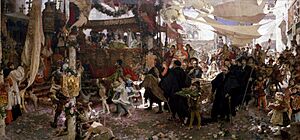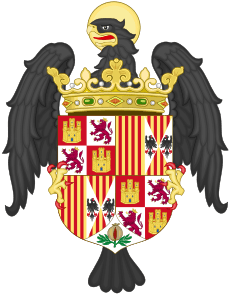John, Prince of Asturias facts for kids
Quick facts for kids John |
|
|---|---|
| Prince of Asturias, Prince of Girona, Duke of Montblanc, Count of Cervera, and Lord of Balaguer | |
 |
|
| Born | 30 June 1478 Seville, Spain |
| Died | 4 October 1497 (aged 19) Salamanca, Spain |
| Burial | Real Monasterio de Santo Tomás in Ávila |
| Spouse | |
| House | Trastámara |
| Father | Ferdinand II of Aragon |
| Mother | Isabella I of Castile |
John, Prince of Asturias and Girona (born June 30, 1478 – died October 4, 1497), was the only son of King Ferdinand II of Aragon and Queen Isabella I of Castile. He was the heir apparent (meaning he was next in line to the throne) to both their kingdoms for almost his entire life.
Contents
Early Life of Prince John
John was born on June 30, 1478, in Seville, Spain. His parents were Queen Isabella I and King Ferdinand V (who was also Ferdinand II of Aragon). At the time of his birth, his parents were fighting in the War of Castilian Succession. This war was against Isabella's niece, Juana la Beltraneja, who was married to King Afonso V of Portugal.

John's birth was very important. It helped make Isabella's claim to the throne stronger. When he was born, he had one older sister named Isabella. Later, he would have three younger sisters: Joanna, Maria, and Catherine.
His parents, known as the Catholic Monarchs, won the war against Portugal. To make peace, King Afonso of Portugal sent Infanta Beatrice, Duchess of Viseu, to meet with Queen Isabella. They met in March 1479. Beatrice was Afonso's sister-in-law and Isabella's aunt. They agreed on a peace treaty. As part of the treaty, the former Queen of Portugal had two choices. She could either marry Prince John when he was old enough (which would be many years later) or she could join a convent. Either way, she had to give up her claim to the throne.
John's Childhood and Upbringing
Queen Isabella I was a very caring mother, even though she was a busy queen. John was her only son, so he held a special place in her heart. She often called him "my angel." John's wetnurse (a woman who breastfed and cared for another's child) was Maria de Guzman. People in the 1400s believed a wetnurse could affect a baby's personality. So, they chose healthy women with calm personalities.
John's grandfather, King John II of Aragon, was very interested in the young prince. He told his son Ferdinand that John should not be taught by just one nobleman. This was because a single nobleman might gain too much influence over the boy. In 1492, when Christopher Columbus discovered the island of Cuba, he named it Isla Juana. He did this to honor Prince John, who was the heir to the throne at that time.
Planning Royal Marriages
When John was young, his parents thought about marrying him to Princess Catherine of York. She was the daughter of King Edward IV of England. But King Edward IV died suddenly in 1483. His brother, Richard III, then took the throne. Because of this change, and questions about Catherine's right to the throne, the marriage plans for John and Catherine were stopped.
Isabella and Ferdinand also considered an alliance with Duke Francis II of Brittany. They planned for John to marry the Duke's heir, Anne. However, this plan did not happen, possibly because John was not very strong or healthy.
Later, Isabella and Ferdinand planned a double marriage alliance with Maximilian I, Holy Roman Emperor. This plan involved Maximilian's children, Archduke Philip the Handsome and Archduchess Margaret of Austria. Around the same time, King Charles VIII of France invaded Italy. He marched to take Naples, which was ruled by a branch of John's family (the House of Trastamara). King Ferdinand II was against the French. Since both Spain and the Holy Roman Empire were upset with France, these marriages were a way to create a strong alliance between them.
On January 20, 1495, in Antwerp, a first agreement was made. It included the marriage of Prince John to Maximilian's daughter, Margaret. Also, Maximilian's son Philip was to marry John's sister, Joanna.
Prince John's Education
As the future king, John's education was very important to his parents. His first teacher was Fray Diego Deza, a Dominican friar who taught Theology at the University of Salamanca. Deza later became a Grand Inquisitor of Spain. He mainly taught John about religion. In the late 1480s, Queen Isabella asked the Italian scholar Peter Martyr d'Anghiera to expand John's education.
Isabella also worried that John might become spoiled if he didn't have friends his own age. So, she invited sons of noble families to live at court with him. She also invited slightly older young noblemen. This way, John would have role models to look up to. Among these young men were Nicolás de Ovando y Cáceres, who later became governor of the Indies, and Gonzalo Fernández de Oviedo y Valdés, who became a historian of the Indies.
John's education also made sure he and his friends learned many skills. They learned to ride horses and joust. They also learned to hunt with falcons, play chess and cards, and sing and recite poetry. John was naturally talented in music. He could play the flute, violin, and clavichord very well. He also had a good tenor singing voice and often sang with his siblings and friends at court.
John's Marriage
John's sister, Joanna, left Spain to marry Philip the Handsome in late 1496. Philip's sister, Margaret of Austria, who was 16, married John on April 3, 1497, in Burgos Cathedral. It was a happy marriage, and John was very devoted to Margaret. All of Isabella's children had strong feelings, and even though this was a political marriage, it became a deep love match. Margaret was easy to love; she was fun and had a great sense of humor.
Her first engagement to Charles VIII of France had ended when he turned her down. Her journey to Spain to marry John also seemed unlucky. The ship carrying her hit a storm in the Bay of Biscay. Fearing she might not make it to Spain, she quickly wrote her own epitaph (words for a tombstone):
"Here lies Margaret, the willing bride,
Twice married - but a virgin when she died."
The Death of Prince John
On October 4, 1497, a messenger told John's parents that their son was very ill in Salamanca. He and his wife Margaret had arrived there a week earlier, on their way to his older sister's wedding in Portugal. King Ferdinand immediately rushed to his son's side. Queen Isabella stayed behind, worried about her only son. Ferdinand was with John when he died in the arms of his former teacher, Fray Diego Deza.
John likely died from tuberculosis. His dog, a lurcher named Bruto, whimpered as John died. The dog then stayed by John's coffin during the vigil (a period of watching) in Salamanca's main church. John's heartbroken mother later kept the dog close to her, as if to keep the memory of her beloved son alive. Six months later, on April 2, 1498, Margaret gave birth to their only child, a stillborn girl.
What Happened Next
John's death was soon followed by the death of his sister Isabella in 1498. Her only child, Miguel de la Paz, died in 1500. Because of these deaths, the Spanish kingdoms passed to John's younger sister, Joanna. She and her husband, Philip the Handsome, and their future children (who were from the Habsburg family) would inherit the thrones. Philip even declared himself and Joanna as 'Princes of Castile'. John's parents saw this as disrespectful to their deceased son-in-law.
See also
 In Spanish: Juan (heredero de los Reyes Católicos) para niños
In Spanish: Juan (heredero de los Reyes Católicos) para niños



